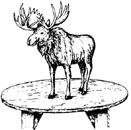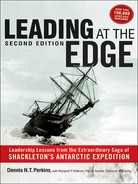Identifying Hidden Conflicts: Conducting a Moose Round-Up

One of the key issues leaders face is how to uncover conflicts that may slow down the expedition. Until the sources of friction are identified, problems will persist and potentially get worse. The challenge is how best to create a safe venue where issues can be discussed and ultimately resolved. If leaders truly wish to understand and work through problems, the following exercise can help.
As described in Chapter 7, a Moose is a latent conflict that everyone knows about but no one discusses. Examples include performance problems, ineffective organizational structures, and leadership actions that send a mixed message. The Moose Round-Up is intended to identify these problems so they can be dealt with openly.
At first impression, the Moose metaphor might seem too contrived, but we have found that the metaphor—sometimes employed with a stuffed moose and even a moose call—is remarkably effective.
Before starting a Round-Up, it’s important to ask three questions. First, is this the right time to engage in the process? Although many conflicts need to be dealt with, if the expedition is in the middle of an avalanche it might make sense to wait until the sliding stops. Second, are you really open to honest feedback? The exercise will be effective only if the leader and the team are willing to talk candidly about problems and to work together to find solutions. Third, is this an issue that needs to be resolved in a group setting, or is it best dealt with one-on-one? A caveat here is that some leaders attempt to resolve group issues with a series of one-off conversations. If it’s a group problem, then it needs to be solved in a conversation with the entire team.
Assuming the answers to these questions are affirmative, the next step is to designate a Moose Wrangler. The Wrangler—ideally someone who does not report directly to the leader—should be someone who understands the organization and who can be trusted to talk about issues in confidence. The Wrangler will be responsible for collecting the issues for discussion—for “rounding up the Mooses.”
Once the Wrangler has been identified, the leader brings the team together to explain the concept of the Moose, the process for rounding them up, and the outcome: what the team can expect from the exercise.
If there are any questions or concerns, people should be encouraged to raise them. It is important for the leader to establish an atmosphere of trust and demonstrate a genuine willingness to address concerns.
Next, the Wrangler asks the team to identify any “Mooses on the loose” in the organization. The worksheet provided asks team members to rank each Moose on a scale from 1 to 10, with 1 on the response scale equivalent to “mildly annoying” and 10 signaling “extremely problematic.” Worksheets are completed anonymously, then returned to the Wrangler for compilation. Confidentiality is critical, especially since some people may be concerned that their handwriting could compromise anonymity.
Once all the worksheets are collected, the Wrangler compiles the findings. Each Moose is given a score by averaging the ratings from the individual employees. For example, if one issue appears on four different worksheets, the ratings are added together and divided by four. The Wrangler and leader review the results, which list Mooses in order of size.
The leader–Wrangler meeting should occur shortly before a full team meeting. The leader needs to understand the issues that will surface, but not so much in advance as to ruminate excessively. At the full team session, the Wrangler presents the results of the Moose Round-Up and provides an opportunity for discussion and clarification.
Moose Round-Up Worksheet

A Moose is a latent conflict that everybody knows about but nobody discusses. In the space below, list any difficult issues or conflicts that get in the way of organizational effectiveness. Rank each Moose on a scale of 1 to 10, with 1 being “mildly annoying” and 10 being “extremely problematic.”

Once the Mooses are identified, the leader and the team can start the process of working through the issues together. Although solutions often take time, once conflicts are out in the open they are no longer Mooses—only undiscussable secrets qualify!
